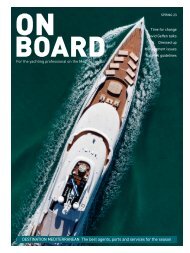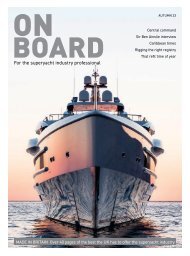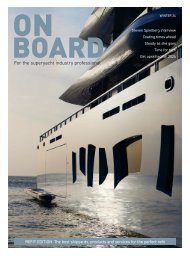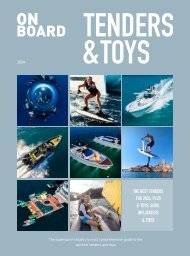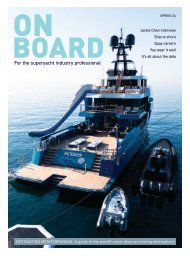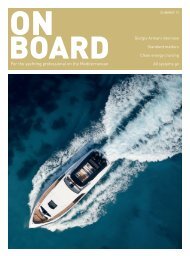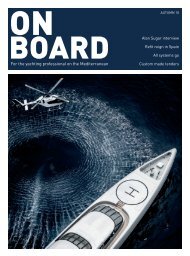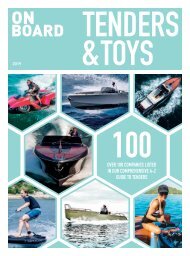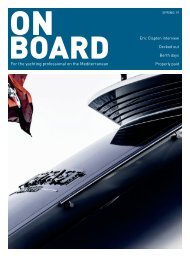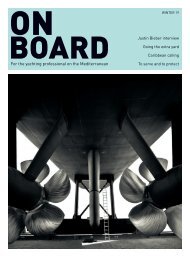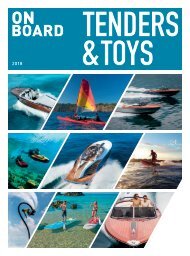ONBOARD Magazine summer 2021
The magazine is published quarterly and is the only publication aimed purely at the superyacht professional on the Mediterranean. Produced here on the Côte d’Azur, ONBOARD is a B2B industry magazine with a consumer feel. Designed to be entertaining and informative in equal balance, ONBOARD is packed with varied articles on superyacht paint & coatings, crew training, essential refit services, crew uniforms, shipyards, the very best superyacht chase boats, product launches and features from leading industry experts on relevant superyacht matters. If you need to get your products and services in front of the right crew and industry buyers, then talk to us.
The magazine is published quarterly and is the only publication aimed purely at the superyacht professional on the Mediterranean. Produced here on the Côte d’Azur, ONBOARD is a B2B industry magazine with a consumer feel. Designed to be entertaining and informative in equal balance, ONBOARD is packed with varied articles on superyacht paint & coatings, crew training, essential refit services, crew uniforms, shipyards, the very best superyacht chase boats, product launches and features from leading industry experts on relevant superyacht matters.
If you need to get your products and services in front of the right crew and industry buyers, then talk to us.
Create successful ePaper yourself
Turn your PDF publications into a flip-book with our unique Google optimized e-Paper software.
ADVERTORIAL
FINDING THE HOT SPOT
Tony Dale discusses the uses of thermal imaging systems for the
prevention of yacht electrical outages and engine room fires
hot surfaces is a recipe for disaster in the
event of fuel system failure. The International
Convention for the Safety of Life at Sea
(SOLAS) states that vessel parts with
temperatures above 220°C that may be
impinged as a result of a fuel system failure
must be properly insulated. Likewise, hot
surfaces, electrical installations and other
sources of ignition must be screened and
suitably protected to avoid oil spray or oil
leakage onto them.
With a host of superyacht condition
monitoring systems available
today, thermal imaging plays a key
part in protecting owners’ and stakeholders’
investment, including crew safety. From
stabilised roof mounted systems turning
night into day to aid navigation, to portable
handheld thermal imagers aiding yacht rescue
teams to see through smoke-filled corridors
and inside cabins, or engineers tasked to
identify failing electrical equipment to prevent
blackouts and electrical fires. There is a
range of thermal imaging devices currently
on the market tailored to suit all yacht
needs and budgets.
In principle, all thermal imaging devices
do the same thing, they passively detect
infrared energy from a warm surface, and
create a usable image. In essence, energy
passes through an imager’s germanium
lens onto a micro-bolometer array and is
converted to electrical signals. An algorithm
processes the data and assigns a colour and
temperature value, for a qualified engineer
to analyse and interpret.
With experience in both the superyacht
industry and with major offshore energy
producers, Dale has been conducting
thermography inspections over the past
20 years in over 40 countries for their
annual maintenance inspections and warranty
purposes. It has become evident vessel
engineers tasked with performing routine
maintenance checks are becoming more
reliant on thermal imaging devices to identify
system deficiencies before an outage occurs.
Yacht fires are caused by three primary
reasons: electrical system failures,
machinery failure and/or human activities.
While the probability of fire occurrence is
low, the potential for electrical fires is high
due to the tens of thousands of connections
on-board.
Whereas motor layshafts may suffer bearing
fatigue and misalignment issues, each
revealed as heat; and engine rooms with
ill-fitting exhaust insulating wrap exposing
Regardless of the size or type of equipment on
board, yacht electro-mechanical systems are
vulnerable to the harsh marine environment,
oxidation, vibration, wear and service care,
(or lack of it). With yacht ownership changing
more frequently – (particularly in the <40m
yacht market) and differing maintenance
and running cost histories exacerbated by
a yacht’s age, everything leads towards the
need for additional effective maintenance and
service improvement measures, including
a thermal survey.
A regular well-planned maintenance regime is
designed to keep a yacht seaworthy. It is the
ISM Code that addresses the responsibilities
of the people who manage and operate yachts
over 500 gross tons. Stipulating the need
for maintenance procedures with regular
inspections to record non-conformities and
corrective activities undertaken. Guidelines
and marine notices published by the MCA
and Classification Societies all recognise the
benefits of additional inspections, particularly
the versatility of Thermographic Surveys for
regular and five yearly periodic survey use.
In summary, a Thermographic Survey is
non-invasive, cost-effective and timely,
meaning operational uptimes are maintained,
regardless of yacht size. Annual service
agreements using an accredited third-party
company ensures impartiality, insurance and
audit compliance. Drawing on industry best
practices, experts like Geo Therm Ltd are
capable and credible to thoroughly survey
a yacht’s electro-mechanical systems to
identify thermal deficiencies to prevent the
risk of blackouts, downtime, and fire.
For more details
Tel: +44 (0)1502 723 241
or visit www. geothermltd.co.uk
ONBOARD | SUMMER 2021 | 27



